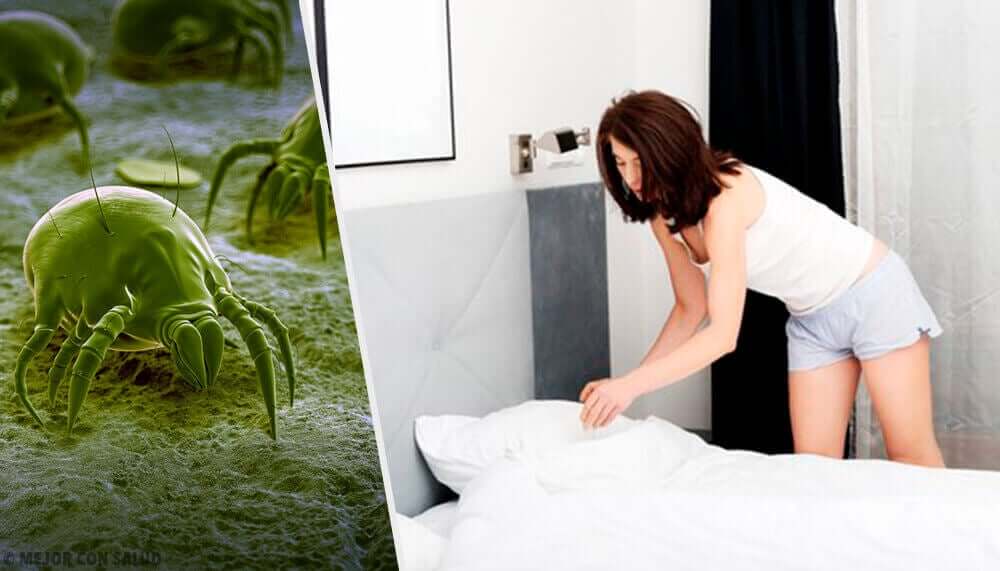Living with Dust Allergy


Written and verified by the doctor Leonardo Biolatto
When we talk about a dust allergy, we’re actually referring to the allergy to dust mites that live in this environment. You can’t be allergic to the dust itself, but you’re most likely allergic to those tiny insects that live among its particles.
For those who suffer from it, it’s difficult to live with this condition on a daily basis. To cope with it, you must implement certain changes. If you want to have a better quality of life, in this article we’ll detail some measures to overcome this condition. Take note!
What are dust mites?
Dust mites are a small organism that can only be seen through a microscope. They have a great capacity to develop in different environments, although there are certain conditions that are very favorable to them.
Most of us know that these beings require relatively high humidity to survive and a temperate temperature. For this reason, they’re more frequent in tropical coastal areas and are less present in mountain environments.
The best seasons for them are the transitional ones, such as autumn and spring. This is why dust allergy sufferers may find their condition exacerbated twice a year. The exacerbation is often falsely attributed to a supposed increase of dust in the environment.
Symptoms of dust allergy
Those who suffer from this health issue, besides learning to live with dust allergy, must learn to identify and treat the symptoms that arise from it. This allergy can take three clinical forms:
- Conjunctivitis. This is the inflammation of the ocular conjunctiva. The symptoms are tearing, ocular itching, and swelling of the eyelids. Vision is altered due to the inflammation and the eye becomes red.
- Rhinitis. This is the inflammation of the mucous membrane of the nose. When rhinitis is present, there’s a runny nose called rhinorrhea, nasal itching, and sneezing. According to an article in the Revista de la Sociedad Boliviana de Pediatría, there’s usually a clear and transparent secretion through the nostrils. This condition can also obstruct the upper airway making breathing momentarily difficult.
- Asthma. The most severe form of dust allergy is the development of allergic asthma. The bronchi close in reaction to the external agent and the patient suffers from dyspnea, i.e. shortness of breath. Bronchial wheezing accompanies asthma as a characteristic breathing sound.

Keep reading: The Difference Between Milk Allergy and Lactose Intolerance
Steps to take to live with dust allergy
Living with dust allergy involves making changes in the environment. When the affected person is a child, the parents will be in charge of making the necessary adjustments in the environment to make it less allergic. The general measures to be applied to coexist with this condition are the following:
- Don’t spread dust when cleaning. To do this, it’s best to clean the furniture with damp cloths.
- Anti-dust bedding. There are pillowcases and mattress covers with special materials that repel dust and prevent it from adhering.
- Wash bed linen once a week. Washing should be done with hot water. This way it’s easier to eliminate the mite.
- Lower the humidity. A dehumidifier is a good option for people with dust allergies. The goal is to lower the humidity in the room to less than half.
- Vacuuming. A vacuum cleaner should be part of the cleaning routine. If the appliance has a microfilter or HEPA filter (high efficiency), even better.
- No carpets. If the house where the allergic person lives has carpets, it’s best to remove them. Carpets, due to their humidity and temperature, are the ideal place for the proliferation of dust mites.
- Washable soft toys for children. In the allergic pediatric age, toys can carry mites. The object most prone to their proliferation is the stuffed animal. Therefore, stuffed toys that can’t be washed in hot water should be avoided.

Discover more: Great Ways to Disinfect Your Bedroom Naturally
Medical treatments
In addition to the measures the person should implement in the environment to live with dust allergy, the specialist will most likely prescribe some medications. They aren’t drugs for continuous use, but they can be of prolonged use.
According to a Mayo Clinic publication, medical treatments to improve dust allergy symptoms include the following:
- Antihistamines. Medications such as loratadine or diphenhydramine decrease the production of the substances that trigger the allergic reaction in the human body.
- Corticosteroids. Whether taken orally, as a nasal spray or in asthma inhalers, they’re a therapeutic option. These include betamethasone, dexamethasone, prednisone and fluticasone.
- Decongestants. To manage symptoms of rhinitis, the doctor may prescribe decongestants in combination with an antihistamine. You can’t use them for a continuous period of time; however, they help to get rid of the symptoms more quickly.
- Immunotherapy. Allergologists, when diagnosed with dust allergy, may suggest immunization therapy. This consists in the systematic application of vaccines with low doses of dust mite substances. The doctor gives these vaccines for a few years until the body is desensitized to what causes the allergy.
As you can see, there are several alternatives to mitigate and prevent the symptoms of dust allergy. We know that it’s very difficult to have a completely clean house, but if you follow these recommendations and make some adjustments to your habits you’ll achieve a better quality of life. What are you waiting for?
All cited sources were thoroughly reviewed by our team to ensure their quality, reliability, currency, and validity. The bibliography of this article was considered reliable and of academic or scientific accuracy.
- Pérez Pacaréu, Marisela L., et al. “Sensibilización a diferentes tipos de ácaros en pacientes adultos.” Revista Cubana de Medicina 41.2 (2002): 74-80.
- Moreno, Liliana, Luis Caraballo, and Leonardo Puerta. “Importancia médica de los alergenos de ácaros domésticos.” Biomédica 15.2 (1995): 93-103.
- Machín, María Inmaculada Sánchez. Ácaros de almacén y alergia. Diss. Universidad de La Laguna, 2016.
- Clínica Mayo. Dust Mite Allergy. (2019). Recuperado el 26 de enero de 2021. https://www.mayoclinic.org/diseases-conditions/dust-mites/diagnosis-treatment/drc-20352178
- Mendoza Amatller, Alfredo, & Mansilla Canelas, Gonzalo. (2002). Rinitis alérgica. Revista de la Sociedad Boliviana de Pediatría, 41(1), 50-53. Recuperado en 26 de enero de 2021, de http://www.scielo.org.bo/scielo.php?script=sci_arttext&pid=S1024-06752002000100017&lng=es&tlng=es.
This text is provided for informational purposes only and does not replace consultation with a professional. If in doubt, consult your specialist.








